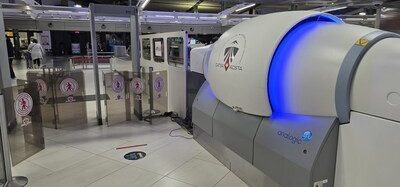The integrated approach to Airport security
Posted: 26 January 2011 | Uwe Karl, Head of Building Technology at Siemens (Airport Solutions) | No comments yet
Security has become an ever increasing feature of our daily lives and nowhere is this more readily apparent than in the airport. For the majority of passengers, the most overt indicator is the queue at the security checkpoint as more rigorous checks on passengers and their luggage cause bottlenecks.
While passenger and baggage screening understandably remains a high priority for airports, a more holistic approach is often being adopted, one which brings together the different security threats that are faced and deals with them through interoperable solutions using fully integrated systems.
Security has become an ever increasing feature of our daily lives and nowhere is this more readily apparent than in the airport. For the majority of passengers, the most overt indicator is the queue at the security checkpoint as more rigorous checks on passengers and their luggage cause bottlenecks.
While passenger and baggage screening understandably remains a high priority for airports, a more holistic approach is often being adopted, one which brings together the different security threats that are faced and deals with them through interoperable solutions using fully integrated systems.
Taking this a stage further, i.e. beyond just the confines of security, building automation, as well as fire detection and suppression, is increasingly being applied in an integrated way. The environmental challenges faced by airports has been a particular driver in this market development, with the need to reduce energy consumption through improved heating, ventilating and air conditioning (HVAC) systems also being sought through using security and fire systems more intelligently, efficiently and effectively.
Free webinar – The future of asset management in global aviation
15 January, 2026, 02:00PM GMT
Join this virtual panel to hear from some of the AtkinsRéalis and aviation sector experts as we discuss how asset management is changing and the impact it will have on the future operations of airports throughout the world.
A simple example is how an access control system can determine if rooms within the airport are actually occupied and, if not, turning off the lighting, heating, air conditioning etc. ‘Green’ is very much at the heart of current air transport thinking, not only in terms of how to reduce the environmental impact of actual air travel but also in how the buildings and the airport infrastructure can help in this process.
The threats
The increased spend on anti-terrorist measures from governments and businesses worldwide demonstrates the effect that security breaches have wrought. In terms of the aviation sector, 9/11 is the highest profile and most significant attack in aviation history, but many other incidents have served to highlight that airports and airlines need to constantly review and update their security measures and procedures.
In March 2008, armed police responded to a major security alert at London Heathrow when a man broke through the perimeter fence and ran on to the runway clutching a bag. He was seized by police and a controlled explosion was carried out on the bag. At the nearby Stansted Airport, only a few months later protestors from the ‘Plane stupid environmental campaign group’ cut through fences and staged a five hour protest on the runway. Many flights had to be cancelled and passengers had to make alternative arrangements.
Those working in airport security could certainly add to such examples, ones which are not only disruptive but put the lives of passengers and airport staff in jeopardy: the IRA mortar attacks of the early 1990s, the failed missile attacks on a passenger plane in Kenya in 2002, and the burning car driven into the terminal of Glasgow Airport in 2007. All highlight the need for security to be at the heart of almost every area of modern air transport.
From perimeter to the air
A key factor in effective security is to adopt an approach which seeks to recognise all the threats throughout the process, from the perimeter protection of the airport through to preventing thefts from the car parks, efficient and transparent passenger processing, luggage and cargo screening procedures and on to general airport operation and air transport management.
That is not to say that a single solution to airport security exists – it does not. But, by adopting an integrated approach, airport operators can better protect all operating and value chain processes, without gaps. In terms of security this will typically include access control, video surveillance, intrusion detection, alarm management and evacuation.
When connected with passenger related data like information about the flight, checked baggage and current location inside the airport, intelligent recognition systems and behaviour pattern recognition, the picture of integrated security becomes even more complete. As already stated, while many of these functions are being increasingly integrated, so too is fire protection, energy management and automation systems for the control of heating, ventilating and air conditioning. This trend will continue, particularly in light of airports needing to be economically sustainable, irrespective of their size, by 2030 which will require improved operational processes and intelligent energy management systems.
Video surveillance
Returning to video surveillance, this is undoubtedly one of the growth areas in security. The increased use of surveillance in retail and public security applications has generated more of the media headlines but its use in all areas of airport applications has certainly grown, particularly with the introduction of more intelligent, powerful algorithm-based technology.
One of the problems with conventional video surveillance is the limitations of the human part of the process. Research has shown that an observer viewing two monitors with automatic image switchover will miss up to 45% of all activity in scenes after only 12 minutes. After 22 minutes, this increases to up to 95%. When you realise that these results are for only two monitors and that an airport will inevitably have a large number of video signals, the need to recognise this problem becomes clear. Information overload is often seen as a particular problem of modern times and in terms of monitoring the output from video surveillance cameras, it has certainly lead to extensive research into how its effects can be minimised.
It is a challenge to find ways to overcome these large ‘video walls’ of monitors showing live video streams and hoping that an operator will be able to spot something. As digital systems are replacing the older analogue systems, this opens up significant opportunities for automating some of the identification processes. By adopting intelligent software algorithms, companies supplying video surveillance solutions can continuously examine camera signals and provide an alert only when required.
Airports, along with other applications requiring security provision over large, extensive sites, are increasingly adopting wide-area surveillance systems. These use networks to transmit over wide areas, utilising the most powerful software, allowing systems to classify more than 50 simultaneous, independent objects per camera: for example identifying a plane, a person, a car, a truck etc. Such systems evaluate and monitor all sensor and camera signals, using just one large screen to display only the live images in the case of an alarm or suspicious event. The operator can then investigate further to validate the event using the camera’s pan, tilt and zoom controls, or playback the image to see what caused the alarm. This allows security personnel to focus on potential threats and stops attempted security breaches before they occur.
It is a case of using analytics to do the monitoring and to highlight potential threats, thereby removing much of the boredom factor which can seriously impact on the effectiveness of the operator. The capacity such systems offer to investigate and visually verify security incidents can also be applied to fire. Video fire controllers are now readily available which can transmit images over a network to the control room to allow the operator to verify the alarm. Evacuation of an airport is obviously a major and costly exercise for airport operators and airlines alike. Video technology can therefore be used to reduce the potential impact of nuisance alarms from accidental or malicious activation of call points or false alarms from detectors.
Over recent years, terrorist attacks have been carried out both outside of airport terminal buildings – abandoned cars and trucks – and indoors – abandoned boxes, bags or luggage. Employing algorithms within the video technology to automatically detect abandoned objects has therefore become another useful feature in an airport security surveillance application. The most obvious application and one that is critical in an airport scenario is identifying a potentially explosive device. However, this feature has applications beyond identifying unattended objects, as it can be used to keep designated areas clear of obstructions. In the case of an airport terminal, this could be used, for example, to keep the all important fire exits clear.
Continuing the fire safety theme and taking integration beyond security, a fire situation is an effective way of demonstrating the benefits of a more comprehensive approach to integration. If the building comfort, fire and security systems are all working together, should a fire break out a whole range of automated actions can be triggered: elevators are taken out of use when empty; doors leading towards the source of the fire are closed while those leading to safety are opened; ventilation fans are activated to take smoke away; emergency lighting is turned on to guide people along designated escape routes. And, while all this is happening automatically, full monitoring of the developing situation is available through video surveillance, providing invaluable information and guidance on suitable actions to be taken by the emergency services and first responders.
The monitoring element can also be applied to essential equipment within the building’s day to day operations e.g. temperature readings on HVAC equipment. Automating this monitoring can trigger an alarm if a deviation from preset values occurs, alerting an engineer to check and fix the problem before it has the opportunity to develop into something serious and potentially having to shut down the building comfort systems. This is effectively adopting a proactive rather than a reactive approach to service and maintenance.
Coping with increased volumes
The sheer size of an airport and the range of operations carried out on a daily basis means that it is an extensive and a complex site in terms of security provision. By using image analysis to identify and automatically highlight suspicious objects and potentially threatening incidents, security personnel can focus on responding to and acting upon such threats rather than simply monitoring the video channels. By integrating video surveillance with other systems, such as access control and intrusion detection through adopting what the security industry refers to as ‘open systems architecture’, many of the security requirements can be performed through a single system. This trend for interoperability through integration is undoubtedly set to continue. The highly integrated security systems increasingly being adopted will provide for an efficient and safe flow of passengers and will be able to cope with high volumes in the airport and beyond, even covering rail transportation systems, for example, as these feature more prominently in the way airport systems are designed.
For many airports, handling the required passenger and cargo capacity is already stretching sites to their limits. The discussions to extend London Heathrow with yet another runway or even to build a whole new airport in the Thames through land reclamation similar to that employed at Hong Kong’s Chep Lap Kok, demonstrates the challenges facing the industry. Increasing capacity requires swifter and more efficient handling of passengers and cargo and further reducing aircraft ground time. This is where innovative concepts are required, seeking ways in which systems can integrate and interoperate to improve the efficiency of airport buildings and, at the same time, make that all important positive contribution to environmental protection.
Today, there are over 1,670 airports worldwide transporting 2 billion passengers and 40% of exported goods annually. As this number is predicted to increase, with the megatrend towards large cities and urbanization showing that by the year 2030 the majority of the world’s population will live in large cities and the surrounding areas (over 84% of the population of industrialized nations will be living in cities), it is essential to explore routes of sustainability. Airports are and will remain the most important hubs for passenger and cargo travel between cities, countries and continents. Therefore, ensuring that they are able to continue to provide a gateway to the world which is safe and secure has never been more critical.
About the Author
Uwe Karl has worked for Siemens in the field of fire safety, security and energy efficiency since graduating from university in 1981. He moved to South West Germany and became account manger for the Stuttgart region and after that key account manager for customers like Mercedes Benz, Alliance Insurance and Southwest German Broadcast in Stuttgart. Later in Munich he worked in the HQ for International Security Projects and in Karlsruhe he was head of a group for SBT Intercompany Business. Since 2002 he is Director for BT Airport business and a member of the Market Development Board “Airports” representing the Division Building Technologies in airport projects, in conferences, on exhibitions and in professional articles. During that time he was core team member for the “Siemens Airports Business Strategy” and “Future of Airports 2030” project. The actual focus is on the regions EMEA and USA with Security and Energy Efficiency Solutions for Airports.
Stay Connected with International Airport Review — Subscribe for Free!
Get exclusive access to the latest airport and aviation industry insights from International Airport Review — tailored to your interests.
✅ Expert-Led Webinars – Gain insights from global aviation leaders
✅ Weekly News & Reports – Airport innovation, thought leadership, and industry trends
✅ Exclusive Industry Insights – Discover cutting-edge technologies shaping the future of air travel
✅ International Airport Summit – Join our flagship event to network with industry leaders and explore the latest advancements
Choose the updates that matter most to you.
Sign up now to stay informed, inspired, and connected — all for free!
Thank you for being part of our aviation community. Let’s keep shaping the future of airports together!


















